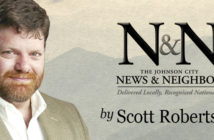So there I was, minding my own business, driving along a back road just past dawn, grousing to myself about the 25 mph speed limit, when I rounded a curve and almost ran smack into a deer. Far from the fast-moving, white-tail-flashing stereotype, it was lazily ambling across the road. The dang thing paid me no mind whatsoever. Had I not been observing that speed limit, I would have been part of a growing statistic: the number of automobile-deer accidents each year.
According to numbers from State Farm Insurance, which has good business reasons to keep up with such things, the odds drivers will hit a deer in Tennessee are 1 out of 143, above the national odds of 1 in 162. That makes us about average, 26th out of 50 states, but around this time of year, those odds rise. The most likely times for deer-auto collisions are October, November and December.
Once upon a time, deer sightings were fairly unusual in areas you would not normally consider rural. That’s changing. Even my neighborhood, well inside the Johnson City limits, is home to a family of deer. They graze on the acorns in my yard almost every morning and can be heard traipsing through the fallen leaves in the back yard after dark. Like that deer I met on the road, they are mostly unfazed by humans. The perception I had as a child that deer were shy, wild animals of the forest is but a romantic fantasy today. Deer are ubiquitous.
As a driver, you do not want to hit a deer. Of course, you do not want to hit anything, but folks always seem surprised by how much damage is done to the automobile in car-deer collisions. The insurance stats say the average accident results in a claim of $4,175. That sounds low to me, having seen what happened to the jeep a friend of mine was driving one morning when he and a doe had an unfortunate meeting.
The nice folks at the insurance company offer some helpful advice for driving in areas where deer may be:
• Slow down. Reaction time is key.
• If you see one deer, be prepared for more deer to cross the road.
• Pay attention to deer crossing signs. They’re there for a reason.
• Always buckle up – every trip, every time.
• Use your high beams to see farther, except when there is oncoming traffic.
• Brake if you can, but avoid swerving, which can result in a more severe crash.
• Remain focused on the road. Scan for hazards, including animals.
• Avoid distractions. Devices or eating might cause you to miss seeing an animal.
• Do not rely on products such as deer whistles. They are not proven effective.
Finally, be at your most alert around dawn and dusk. Deer are crepuscular, which is a fancy scientific term for “more active in the twilight hours.” Their natural brown/gray coloration makes deer hardest to see in those semi-lit times. That’s great for avoiding hunters and predators, but lousy for avoiding Kias and Chevrolets. Because deer are most active at the times when they are hardest to see, they are even more susceptible to being hit by a car.
And sure, even at 1 in 143, the odds are good you’ll never hit a deer. But as I learned on that back-country road, it’s worth it to drive as though this might be the day you will have to brake hard to avoid it.





